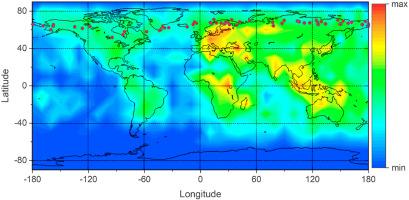Journal of Atmospheric and Solar-Terrestrial Physics ( IF 1.9 ) Pub Date : 2021-05-21 , DOI: 10.1016/j.jastp.2021.105672 P.A. Klimov , K.F. Sigaeva

|
Observations of a faint pulsating UV emission from the atmosphere in the region of auroral oval were made by a highly sensitive satellite telescope TUS with a milliseconds temporal resolution.
The TUS detector was launched in April 2016 on board the Lomonosov spacecraft. TUS was designed to register the extensive air shower (EAS) fluorescent signal from ultra-high-energy cosmic rays in the wavelength range 300–400 nm. EAS fluorescence is a weak and rapidly moving signal in the detector's field of view (FOV). Therefore, the TUS detector was equipped with a 2 m2 mirror and high temporal resolution (0.8 μs) photo detector. The FOV of the device is 6400 km2, the angular resolution is 10 mrad, which corresponds to the km square on the Earth surface. The Lomonosov satellite has a polar sun-synchronous orbit with an inclination of , which provides measurements up to the high latitudes on the night side of the orbit. The detector electronics implements several operating modes that differ in time resolution (from 0.8 μs to 6.6 ms) and measure optical phenomena of different time scales.
We analyze the near-UV glow in the northern polar region (50°–80° N), carried out in a mode with a temporal resolution of 6.6 ms and a waveform duration of 1.7 s. About 2500 observations were analyzed in a wide range of longitudes. A selection of events with the peculiar spatial-temporal dynamics of the signal was made. An analysis of the selected events structure and location relative to the auroral oval shows that fast pulsations are observed during disturbed geomagnetic conditions at the equatorial border of the auroral zone.
中文翻译:

太空望远镜TUS在极光区域中测量的快速近紫外线辐射脉动
通过具有毫秒级时间分辨率的高灵敏度卫星望远镜TUS观测到了极光椭圆形区域中来自大气的微弱脉动UV发射。
TUS探测器于2016年4月在罗蒙诺索夫航天器上发射升空。TUS旨在记录300-400 nm波长范围内的超高能宇宙射线发出的大量空气淋浴(EAS)荧光信号。EAS荧光是检测器视场(FOV)中微弱且快速移动的信号。因此,TUS检测器配备了2 m 2反射镜和高时间分辨率(0.8μs)的光电检测器。设备的FOV为6400 km 2,角分辨率为10 mrad,对应于平方公里在地球表面。罗蒙诺索夫卫星的太阳同步轨道的倾角为,它可以提供直至夜空中高纬度的测量结果。检测器电子设备执行几种工作模式,这些工作模式的时间分辨率(从0.8μs到6.6 ms)不同,并且可以测量不同时间尺度的光学现象。
我们分析了在北极地区(50°–80°N)的近紫外光,该模式以时间分辨率为6.6 ms和波形持续时间为1.7 s的模式进行。在广泛的经度范围内对大约2500个观测值进行了分析。选择了具有特定信号时空动态的事件。对选定事件的结构和相对于极光椭圆的位置的分析表明,在极光区赤道边界的受干扰的地磁条件下观察到了快速脉动。



























 京公网安备 11010802027423号
京公网安备 11010802027423号